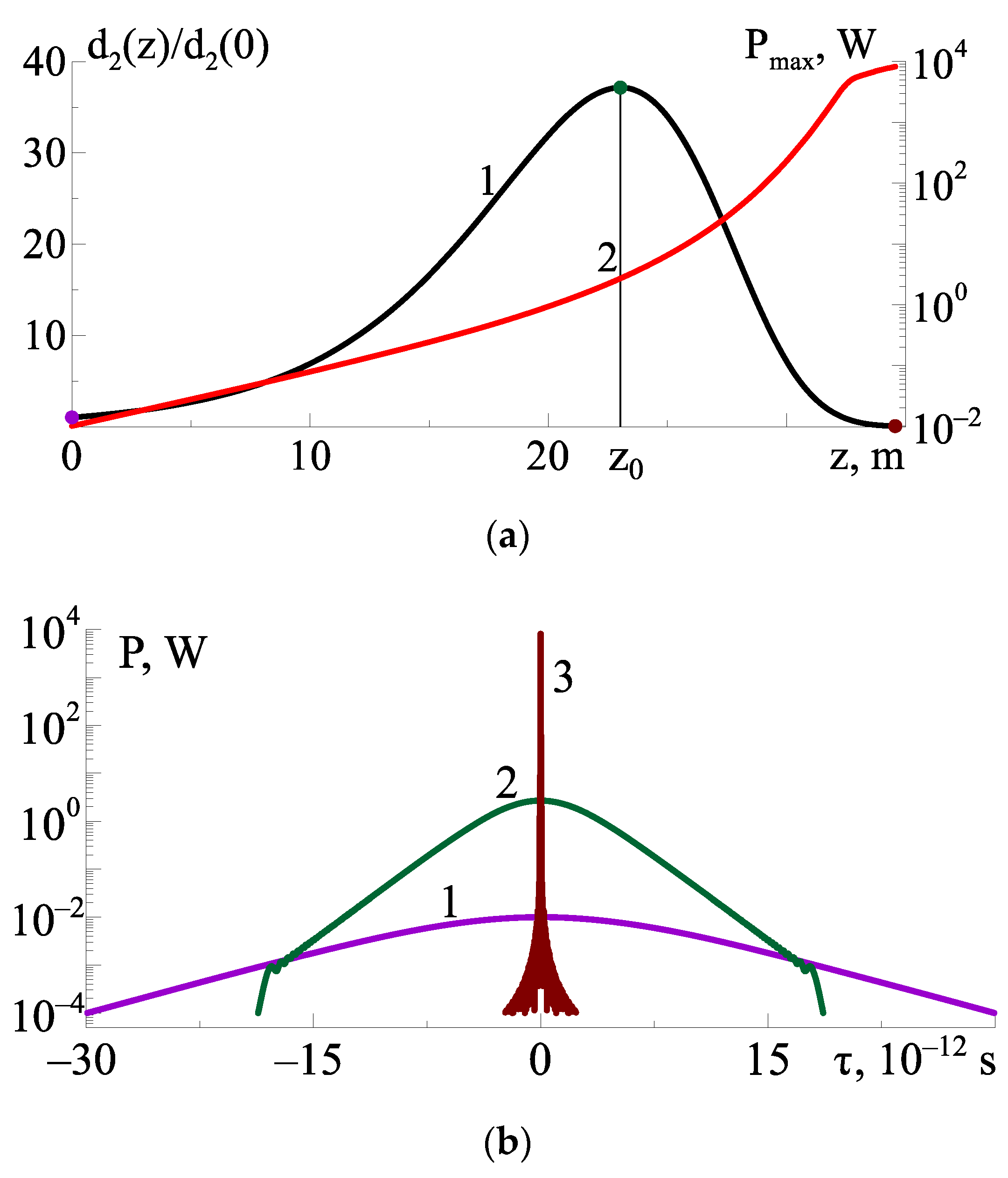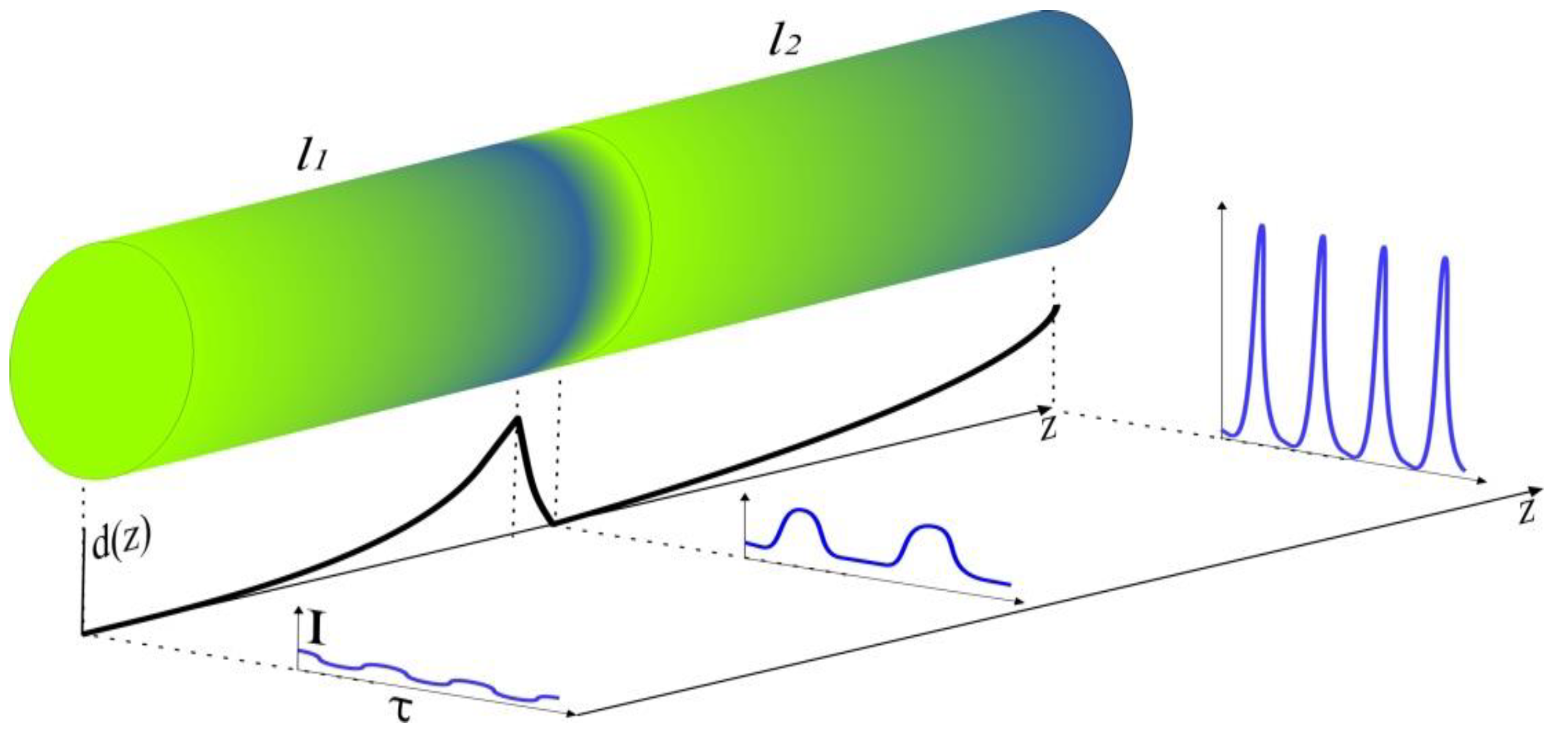Amplification and Generation of Frequency-Modulated Soliton Pulses in Nonuniform Active Fiber Configurations
Abstract
:1. Introduction
2. Basic Equations
3. Amplification of FM Soliton-Like Pulses
4. Induced MI and Generation of FM Soliton-Like Pulse Train
5. Discussion and Conclusions
Author Contributions
Funding
Institutional Review Board Statement
Informed Consent Statement
Data Availability Statement
Acknowledgments
Conflicts of Interest
References
- Reid, D.T.; Heyl, C.M.; Thomson, R.R.; Trebino, R.; Steinmeyer, G.; Fielding, H.H.; Holzwarth, R.; Zhang, Z.; Del’Haye, P.; Südmeyer, T.; et al. Roadmap on Ultrafast Optics. J. Opt. 2016, 18, 093006. [Google Scholar] [CrossRef] [Green Version]
- Fermann, M.E.; Hartl, I. Ultrafast Fibre Lasers. Nat. Photonics 2013, 7, 868–874. [Google Scholar] [CrossRef]
- Akhmanov, S.A.; Vysloukh, V.A.; Chirkin, A.S. Optics of Femtosecond Laser Pulses; American Inst. of Physics: New York, NY, USA, 1992; ISBN 9780883188514. [Google Scholar]
- Kryukov, P.G. Ultrashort-Pulse Lasers. Quantum Electron. 2001, 31, 95–119. [Google Scholar] [CrossRef]
- Agrawal, G.P. Nonlinear Fiber Optics; Elsevier: Amsterdam, The Netherlands, 2019; ISBN 9780128170427. [Google Scholar]
- Geddes, C.G.R.; Toth, C.S.; van Tilborg, J.; Esarey, E.; Schroeder, C.B.; Bruhwiler, D.; Nieter, C.; Cary, J.; Leemans, W.P. High-Quality Electron Beams from a Laser Wakefield Accelerator Using Plasma-Channel Guiding. Nature 2004, 431, 538–541. [Google Scholar] [CrossRef] [PubMed]
- Bolshakov, V.V.; Vorob’ev, A.A.; Uryupina, D.S.; Ivanov, K.A.; Morshedian, N.; Volkov, R.V.; Savel’ev, A.B. Hot Electron Generation in a Dense Plasma by Femtosecond Laser Pulses of Subrelativistic Intensity. Quantum Electron. 2009, 39, 669–674. [Google Scholar] [CrossRef]
- Lourenco, S.; Kowarsch, N.; Scheid, W.; Wang, P.X. Acceleration of Electrons and Electromagnetic Fields of Highly Intense Laser Pulses. Laser Part. Beams 2010, 28, 195–201. [Google Scholar] [CrossRef]
- Bonse, J.; Hohm, S.; Kirner, S.V.; Rosenfeld, A.; Kruger, J. Laser-Induced Periodic Surface Structures-A Scientific Evergreen. IEEE J. Sel. Top. Quantum Electron. 2017, 23, 109–123. [Google Scholar] [CrossRef]
- Buck, A.; Wenz, J.; Xu, J.; Khrennikov, K.; Schmid, K.; Heigoldt, M.; Mikhailova, J.M.; Geissler, M.; Shen, B.; Krausz, F.; et al. Shock-Front Injector for High-Quality Laser-Plasma Acceleration. Phys. Rev. Lett. 2013, 110, 185006. [Google Scholar] [CrossRef]
- Kalaycioglu, H.; Elahi, P.; Akcaalan, O.; Ilday, F.O. High-Repetition-Rate Ultrafast Fiber Lasers for Material Processing. IEEE J. Sel. Top. Quantum Electron. 2018, 24, 1–12. [Google Scholar] [CrossRef]
- Kippenberg, T.J.; Holzwarth, R.; Diddams, S.A. Microresonator-Based Optical Frequency Combs. Science 2011, 332, 555–559. [Google Scholar] [CrossRef]
- Li, X.; Zou, W.; Chen, J. Passive Harmonic Hybrid Mode-Locked Fiber Laser with Extremely Broad Spectrum. Opt. Express 2015, 23, 21424. [Google Scholar] [CrossRef] [PubMed]
- Maddaloni, P.; Cancio, P.; de Natale, P. Optical Comb Generators for Laser Frequency Measurement. Meas. Sci. Technol. 2009, 20, 052001. [Google Scholar] [CrossRef]
- Boscolo, S.; Finot, C. (Eds.) Shaping Light in Nonlinear Optical Fiber; Wiley: New York, NY, USA, 2017; pp. 1–505. ISBN 9781119088127. [Google Scholar]
- Korobko, D.A.; Okhotnikov, O.G.; Zolotovskii, I.O. High-Repetition-Rate Pulse Generation and Compression in Dispersion Decreasing Fibers. J. Opt. Soc. Am. B 2013, 30, 2377–2386. [Google Scholar] [CrossRef]
- Korobko, D.A.; Okhotnikov, O.G.; Stoliarov, D.A.; Sysolyatin, A.A.; Zolotovskii, I.O. Broadband Infrared Continuum Generation in Dispersion Shifted Tapered Fiber. J. Opt. Soc. Am. B 2015, 32, 692–700. [Google Scholar] [CrossRef]
- Korobko, D.A.; Okhotnikov, O.G.; Stoliarov, D.A.; Sysoliatin, A.A.; Zolotovskii, I.O. Highly Nonlinear Dispersion Increasing Fiber for Femtosecond Pulse Generation. J. Lightwave Technol. 2015, 33, 3643–3648. [Google Scholar] [CrossRef]
- Rehan, M.; Kumar, G.; Rastogi, V.; Korobko, D.A.; Sysolyatin, A.A. Compression of Femtosecond Pulses in a Wide Wavelength Range Using a Large-Mode-Area Tapered Fiber. Laser Phys. 2019, 29, 025104. [Google Scholar] [CrossRef] [Green Version]
- Sysoliatin, A.A.; Nolan, D.A. Optical Signal Processing in Dispersion Varying Fiber. J. Nonlinear Opt. Phys. Mater. 2007, 16, 171–184. [Google Scholar] [CrossRef]
- Korobko, D.A.; Okhotnikov, O.G.; Zolotovskii, I.O. Multistage Fiber Preamplifier Employing Spectral Compression for Generation of High-Energy Laser Pulses. J. Opt. Soc. Am. B 2016, 33, 239–245. [Google Scholar] [CrossRef]
- Korobko, D.A.; Okhotnikov, O.G.; Sysolyatin, A.A.; Yavtushenko, M.S.; Zolotovskii, I.O. Optical Amplifier with Tailored Dispersion for Energy Scaling of Similaritons. J. Opt. Soc. Am. B 2013, 30, 582–588. [Google Scholar] [CrossRef]
- Zolotovsky, I.O.; Yavtushenko, M.S.; Sysoliatin, A.A.; Sementsov, D.I.; Yavtushenko, I.O.; Okhotnikov, O.G. Parabolic Pulse Generation in the Nonlinear Nonuniform Fibre Cascade. In Proceedings of the Nonlinear Frequency Generation and Conversion: Materials, Devices, and Applications X, San Francisco, CA, USA, 24–27 January 2011; Volume 7917. [Google Scholar]
- Yavtushenko, M.S.; Zolotovskii, I.O.; Okhotnikov, O.G.; Sysoliatin, A.A. Chirped Pulse Shaping via Fiber Dispersion Modulation. In Proceedings of the Fiber Lasers VII: Technology, Systems, and Applications, San Francisco, CA, USA, 25–28 January 2010; Volume 7580. [Google Scholar]
- Korobko, D.A.; Sysoliatin, A.A.; Yavtushenko, M.S.; Zolotovskii, I.O. A Multistage Fiber Amplifier with a Decreased Rate of Frequency Modulation of Amplified Pulses. Laser Phys. 2013, 23, 095111. [Google Scholar] [CrossRef]
- Sarma, A.K. Modulation Instability in Nonlinear Complex Parity-Time Symmetric Periodic Structures. J. Opt. Soc. Am. B 2014, 31, 1861. [Google Scholar] [CrossRef] [Green Version]
- Krolikowski, W.; Bang, O.; Rasmussen, J.J.; Wyller, J. Modulational Instability in Nonlocal Nonlinear Kerr Media. Phys. Rev. E 2001, 64, 016612. [Google Scholar] [CrossRef] [PubMed] [Green Version]
- Królikowski, W.; Bang, O.; Nikolov, N.I.; Neshev, D.; Wyller, J.; Rasmussen, J.J.; Edmundson, D. Modulational Instability, Solitons and Beam Propagation in Spatially Nonlocal Nonlinear Media. J. Opt. B Quantum Semiclassical Opt. 2004, 6, S288–S294. [Google Scholar] [CrossRef] [Green Version]
- Schukarev, I.; Korobko, D.A.; Zolotovskii, I. Parabolic Pulse Generation in Short Fiber Amplifiers. J. Opt. 2019, 21, 105505. [Google Scholar] [CrossRef]
- Agrawal, P. Modulation Instability in Erbium-Doped Fiber Amplifiers. IEEE Photonics Technol. Lett. 1992, 4, 562–564. [Google Scholar] [CrossRef]
- Chernikov, S.V.; Mamyshev, P.V. Femtosecond Soliton Propagation in Fibers with Slowly Decreasing Dispersion. J. Opt. Soc. Am. B 1991, 8, 1633. [Google Scholar] [CrossRef]
- Akhmetshin, U.G.; Bogatyrev, V.A.; Senatorov, A.K.; Sysolyatin, A.A.; Shalygin, M.G. New Single-Mode Fibres with the Flat Spectral Dependence of the Chromatic Dispersion Varying over the Fibre Length. Quantum Electron. 2003, 33, 265–267. [Google Scholar] [CrossRef]
- Borisova, C.; Zolotovskii, I.; Korobko, D.; Sementsov, D.; Sysoliatin, A.; Yavtushenko, M. Cascade Scheme of FM Pulse Amplification in Length-Inhomogeneous Active Waveguides with Normal Dispersion. In Proceedings of the Fiber Lasers X: Technology, Systems, and Applications, San Francisco, CA, USA, 4–7 February 2013; Volume 8601. [Google Scholar]
- Xu, W.; Zhang, S.; Chen, W.; Luo, A.; Liu, S. Modulation Instability of Femtosecond Pulses in Dispersion-Decreasing Fibers. Opt. Commun. 2001, 199, 355–360. [Google Scholar] [CrossRef]
- Tai, K.; Tomita, A.; Jewell, J.L.; Hasegawa, A. Generation of Subpicosecond Solitonlike Optical Pulses at 0.3 THz Repetition Rate by Induced Modulational Instability. Appl. Phys. Lett. 1986, 49, 236–238. [Google Scholar] [CrossRef]
- Spence, D.E.; Wielandy, S.; Tang, C.L.; Bosshard, C.; Günter, P. High Average Power, High-repetition Rate Femtosecond Pulse Generation in the 1–5 Μm Region Using an Optical Parametric Oscillator. Appl. Phys. Lett. 1996, 68, 452–454. [Google Scholar] [CrossRef]
- Kobayashi, T.; Sueta, T.; Cho, Y.; Matsuo, Y. High-repetition-rate Optical Pulse Generator Using a Fabry-Perot Electro-optic Modulator. Appl. Phys. Lett. 1972, 21, 341–343. [Google Scholar] [CrossRef]
- Conforti, M.; Mussot, A.; Kudlinski, A.; Trillo, S. Modulational Instability in Dispersion Oscillating Fiber Ring Cavities. Opt. Lett. 2014, 39, 4200. [Google Scholar] [CrossRef] [PubMed] [Green Version]
- Demircan, A.; Bandelow, U. Supercontinuum Generation by the Modulation Instability. Opt. Commun. 2005, 244, 181–185. [Google Scholar] [CrossRef]
- Dudley, J.M.; Genty, G.; Dias, F.; Kibler, B.; Akhmediev, N. Modulation Instability, Akhmediev Breathers and Continuous Wave Supercontinuum Generation. Opt. Express 2009, 17, 21497. [Google Scholar] [CrossRef]
- Mamyshev, P.V.; Chernikov, S.V.; Dianov, E.M.; Prokhorov, A.M. Generation of a High-Repetition-Rate Train of Practically Noninteracting Solitons by Using the Induced Modulational Instability and Raman Self-Scattering Effects. Opt. Lett. 1990, 15, 1365. [Google Scholar] [CrossRef]
- Chernikov, S.V.; Taylor, J.R.; Mamyshev, P.V.; Dianov, E.M. Generation of Soliton Pulse Train in Optical Fibre Using Two CW Singlemode Diode Lasers. Electron. Lett. 1992, 28, 931–932. [Google Scholar] [CrossRef]
- Degli-Eredi, I.; An, P.; Drasbæk, J.; Mohammadhosseini, H.; Nielsen, L.; Tønning, P.; Rommel, S.; Monroy, I.T.; Heck, M.J.R. Millimeter-Wave Generation Using Hybrid Silicon Photonics. J. Opt. 2021, 23, 043001. [Google Scholar] [CrossRef]




| Sign | Description | Value | Figures |
|---|---|---|---|
| Peak power of input signal | 0.01 W | 1,3,4 | |
| Input pulse duration | 10 ps | 1 | |
| Initial frequency modulation (chirp) of pulse | 1024 s−2 | 1 | |
| Modulation depth | 0.01 | 3,4 | |
| Modulation frequency | 2 × 1012 s−1 | 3,4 | |
| –10−27 s2/m | 1,3,4 | ||
| Third-order dispersion | −10−40 s3/m | 3,4 | |
| Kerr nonlinearity coefficient | 10−3 (W·m)−1 | 1,3,4 | |
| Raman response time of medium | 5 × 10−15 s | 1,3,4 | |
| Optical fiber material gain increment | 0.1 m−1 | 1 | |
| Optical fiber first section material gain increment | 0.1 m−1 | 3,4 | |
| Optical fiber second section material gain increment | 0.015 m−1 | 3,4 |
Publisher’s Note: MDPI stays neutral with regard to jurisdictional claims in published maps and institutional affiliations. |
© 2022 by the authors. Licensee MDPI, Basel, Switzerland. This article is an open access article distributed under the terms and conditions of the Creative Commons Attribution (CC BY) license (https://creativecommons.org/licenses/by/4.0/).
Share and Cite
Abramov, A.; Zolotovskii, I.; Lapin, V.; Mironov, P.; Yavtushenko, M.; Svetukhin, V.; Fotiadi, A. Amplification and Generation of Frequency-Modulated Soliton Pulses in Nonuniform Active Fiber Configurations. Photonics 2022, 9, 160. https://doi.org/10.3390/photonics9030160
Abramov A, Zolotovskii I, Lapin V, Mironov P, Yavtushenko M, Svetukhin V, Fotiadi A. Amplification and Generation of Frequency-Modulated Soliton Pulses in Nonuniform Active Fiber Configurations. Photonics. 2022; 9(3):160. https://doi.org/10.3390/photonics9030160
Chicago/Turabian StyleAbramov, Aleksei, Igor Zolotovskii, Victor Lapin, Pavel Mironov, Marina Yavtushenko, Vyacheslav Svetukhin, and Andrei Fotiadi. 2022. "Amplification and Generation of Frequency-Modulated Soliton Pulses in Nonuniform Active Fiber Configurations" Photonics 9, no. 3: 160. https://doi.org/10.3390/photonics9030160
APA StyleAbramov, A., Zolotovskii, I., Lapin, V., Mironov, P., Yavtushenko, M., Svetukhin, V., & Fotiadi, A. (2022). Amplification and Generation of Frequency-Modulated Soliton Pulses in Nonuniform Active Fiber Configurations. Photonics, 9(3), 160. https://doi.org/10.3390/photonics9030160





